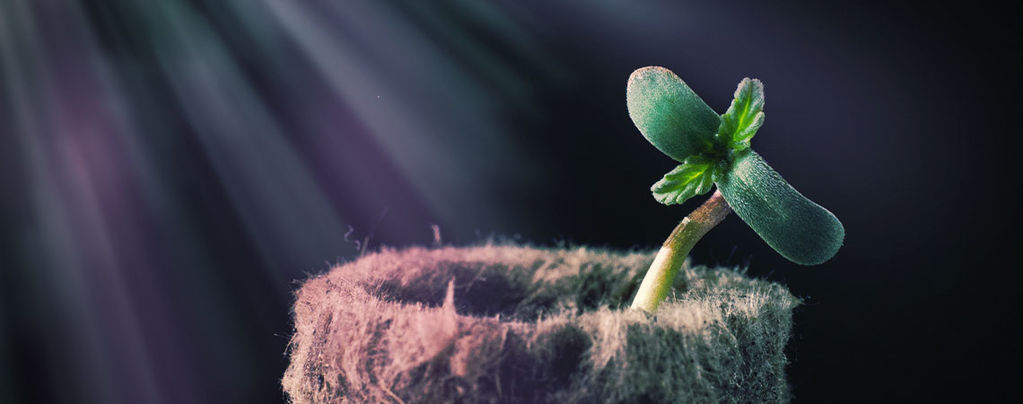
How The Light Spectrum Affects Cannabis
Cannabis is a sun-loving plant. But growing great weed indoors is about more than just sticking a plant under a strong light and hoping for the best. In this article, we'll teach you all there is to know about the light spectrum of your grow lights and how it affects the health, development, and yield of your cannabis plants.
We all know that plants use light to photosynthesise and grow. As a cannabis grower, however, it’s important to understand how different types of light affect your plants, and how to use different grow lights to achieve the best harvest.
In this article, we take an in-depth look at the light spectrum, explore how different types of light affect cannabis, and show you how to use the right types of light at different stages of your grow.
What Is the Light Spectrum?

The solar radiation emitted by the sun includes gamma rays, x-rays, ultraviolet light (UV-A, UV-B, UV-C), radio waves, and visible light. The ozone layer surrounding the Earth helps to reflect most of this radiation, creating the unique conditions that allow life to thrive on our planet.
Of the limited amount of solar energy that passes through the ozone layer, an even smaller amount is visible to the human eye. The light spectrum, also known as the colour spectrum, is a tool we can use to measure and categorise visible light according to its wavelengths.
What Are the Visible Colours of the Light Spectrum?
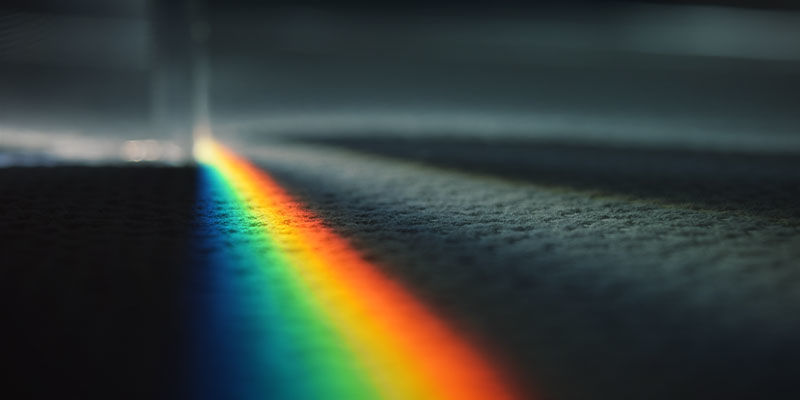
Measured in nanometres (nm), visible light sits between 380 and 750nm on the light spectrum. Violet light has the shortest wavelength and therefore sits at the bottom end of the spectrum, while red light has a longer wavelength and thus sits at the top. In its entirety, the visible light spectrum comprises:
| Red light: | 620 – 750nm |
| Orange light: | 590 – 620nm |
| Yellow light: | 565 – 590nm |
| Green light: | 520 – 565nm |
| Cyan light: | 500 – 520nm |
| Blue light | 430 – 500nm |
| Violet light: | 380 – 430nm |
Light Spectrum vs Colour Temperature
When you shop around for grow lamps, you’ll likely see the term “colour temperature” on spec sheets and websites. Measured in Kelvin (K), colour temperature essentially refers to the visual temperature of that particular light source.
Cooler grow lights with a higher Kelvin temperature typically have a more blue-ish appearance. On the other hand, a warmer light with a lower Kelvin temperature typically has a more orange or reddish appearance.
Keep in mind, however, that simply relying on the colour of a light won’t give you an accurate idea of the spectrum it covers or whether it is appropriate for cannabis cultivation. For that, you’ll need to consider the light spectrum the bulb is capable of producing.
How To Check the Light Spectrum of Your Grow Light
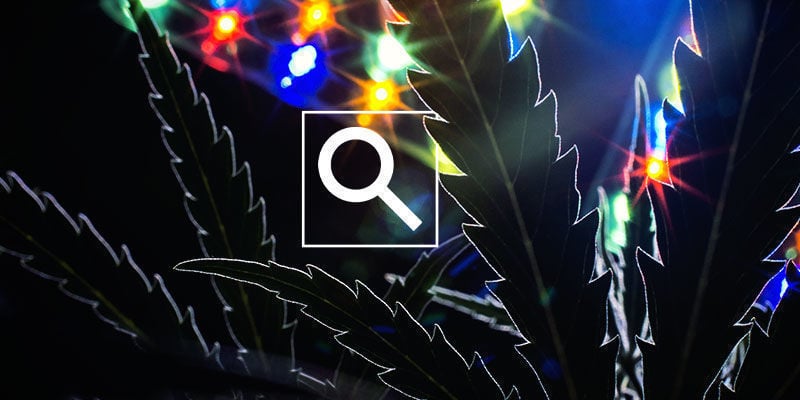
To check the light spectrum of a grow lamp, you’ll first need to mount the lamp on an integrating sphere (a white, hollow sphere lined with fibre optic cable). The sphere you use will need to be the right size, and match your lighting fixture, to ensure your light source doesn’t reabsorb the light that reflects off the interior of the sphere.
You’ll then need to connect the cable from the integrating sphere to a spectroradiometer, which measures the spectral radiance of your grow light. Keep in mind that this kind of test won’t take directionality into account (you’ll need to run a second, more complex test for this).
Spectroradiometers are complex pieces of machinery that retail for anywhere above $350 USD on Amazon. We do not recommend investing in this kind of specialised equipment and running your own light spectrum tests on your grow lights.
Instead, shop around and do research on the lights you’re considering, and contact the retailers or manufacturers for more detailed information about the spectral radiance of the product(s) you’re interested in. This info is all you’ll need to find a grow light with the right light spectrum for cannabis.
What Light Spectrum Do Cannabis Plants Need?
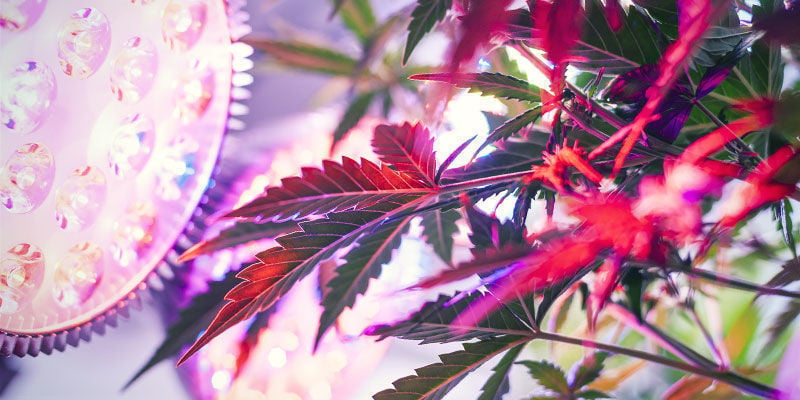
Cannabis is a sun-loving plant. In nature or in an outdoor garden, it usually grows best in a spot that receives direct sunlight all day long. Sunlight delivers a full colour spectrum of light, and therefore helps cannabis plants develop big, resinous flowers rich in cannabinoids and terpenes.
Unfortunately, no grow light on the market can compete with the sun in terms of light energy. However, by paying close attention to the types of grow lights available to you, and tailoring their use to the unique needs of your plants during the different stages of the cannabis life cycle, you should have no problem producing exceptional weed indoors.
Below, we’ll walk you through the changing lighting needs of cannabis plants during the different stages of their life cycle, and how to use grow lights with different light spectrums to achieve heavier yields of top-shelf bud.
Light Spectrum for Cannabis Seedlings
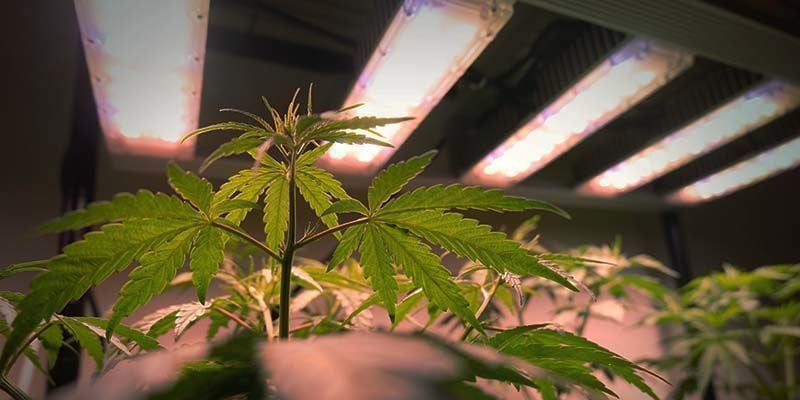
Cannabis seedlings are very fragile, and small slip-ups in your watering schedule or lighting can have dramatic effects on your plants, severely stunting their growth or even killing them altogether.
For the best results in the early stages of your grow, we recommend growing seedlings under low-watt CFL bulbs with a nice, cool light spectrum. Keep your seedlings on an 18/6 light cycle, and make sure they’re no further than 60cm from the top of your canopy to avoid them stretching and developing long, thin, lanky stems.
Once your seedlings have developed their first two true leaves, move them under your regular LED or HID lights to start vegging.
The seedling stage is often one of the trickiest of the entire grow cycle, especially for beginners. However, with the right watering schedule and the lighting setup described above, you should be well underway to growing happy seedlings and giving your plants the perfect start to a healthy life.
Light Spectrum for Vegetative Cannabis Plants
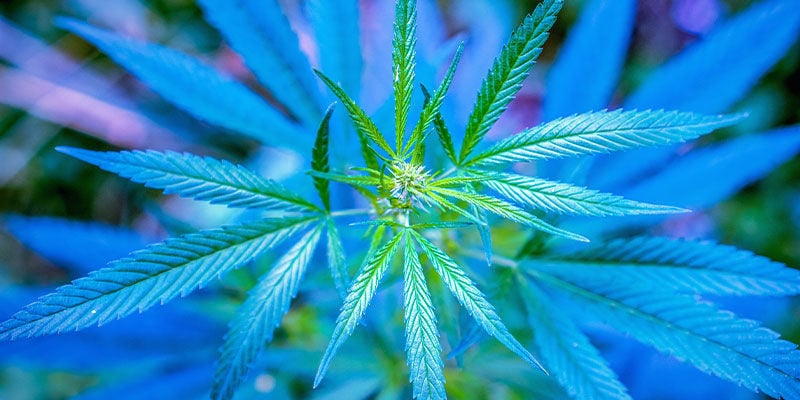
The bloom phase is arguably the stage of the cannabis life cycle we growers look forward to the most. However, you can’t expect your plants to produce big, resinous flowers if they haven’t been allowed to veg properly. And having the right lighting is easily one of the most important factors to ensure healthy vegetative growth in your indoor cannabis plants.
While every cannabis gardener tends to have their own unique approach to growing, it is common practice to let cannabis veg under blue light. While different plants might respond differently to the same lights, sticking to 460nm during the vegetative stage is usually considered the ideal light spectrum for vegging marijuana plants. However, using a grow light that sits anywhere between 400 and 500nm should definitely do the trick.
Remember, the goal during the vegetative phase is to encourage healthy growth so your plants can develop plenty of bud sites. Lights with a slightly cooler spectrum mimic natural sunlight during spring and summer, which is naturally “cooler” due to the angle of the sun.
Using grow lights with a sufficient blue band is also important because they ensure your plants “feel” like they’re growing in direct sunlight. A lack of blue light during the vegetative phase, on the other hand, can encourage plants to stretch and compete for light as if they were growing in the shade.
During veg, most indoor growers use metal halide bulbs, compact fluorescent lamps (CFLs), or T5/T8 lighting fixtures with blue light bands to replicate the high angle of the sun that naturally causes more “blue” light to penetrate the Earth's atmosphere.
We generally encourage growers to use lights with a slightly bluer light spectrum during the first two weeks of the vegetative growth to kickstart their plants’ growth and encourage shorter, stockier growth without stretching.
Light Spectrum for Flowering Cannabis Plants
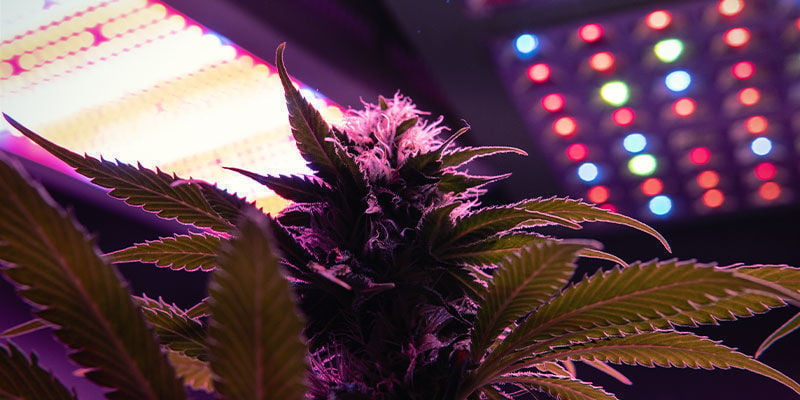
Ah, the flowering stage. What grower doesn’t get edgy (in a completely healthy and positive way) when it’s time to flip their lights and start coaxing their plants into flowering? Flipping your grow lights from 18/6 to 12/12, as you know, tricks indoor plants into thinking that summer is over and it’s time to start flowering. But simply changing the amount of light your plants receive isn’t all you can do to maximise their ability to produce delicious, aromatic, and potent flowers.
Flowering cannabis plants develop the best flowers under warm red light. Lights with a red band between 620–780nm work great, but most growers find that the sweet spot for their flowering ladies is somewhere around 660nm.
Warm red light is super important for flowering cannabis plants because it encourages photosynthesis. Also, red light mimics the naturally lower angle of the sun during the end of summer and autumn, which triggers flowering in cannabis plants when they’re growing outdoors.
For the best results, we typically recommend shopping for grow lights that have two separate functions; one dedicated to the vegetative stage and another dedicated to the flowering stage. These lights are becoming increasingly popular (most modern LED blocks come with them) and take a lot of the guesswork out of flipping your plants from veg into flowering. For more information about what grow lights offer the best light spectrum for cannabis plants, check out the end of this post.
What Light Spectrum for Autoflowering Cannabis?
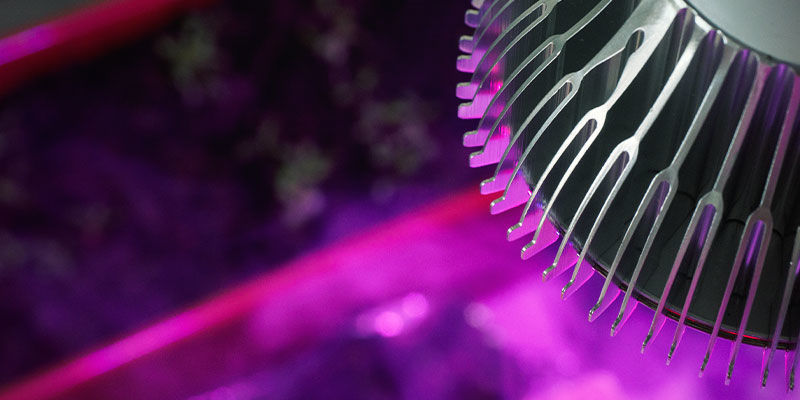
Growing autoflowering cannabis plants differs from growing regular photoperiod strains on many levels. Auto cannabis strains have much shorter life cycles and sometimes benefit from slightly different feeding schedules than their photoperiod cousins. However, you’ll be glad to know that, when it comes to light spectrum, your autoflowering plants should be right as rain under the same light spectrums as photoperiod strains.
What About UV and Infrared Light for Cannabis Plants?
As we mentioned earlier, the visible light spectrum only covers a small portion of the light that enters the Earth’s atmosphere. There are many other forms of light that remain naked to the human eye but can have a huge impact on the health and growth of cannabis plants.
Both UV and infrared light have been shown to benefit cannabis plants, particularly during the bloom phase. Experienced cannabis growers often use both infrared and UV light (UV-B light in particular) to enhance THC production during the flowering stage. Some growers also find that small amounts of infrared and UV light can help plants during veg, encouraging faster, more vigorous growth and the development of plenty of healthy foliage.
Which Grow Light Has the Best Light Spectrum for Cannabis?
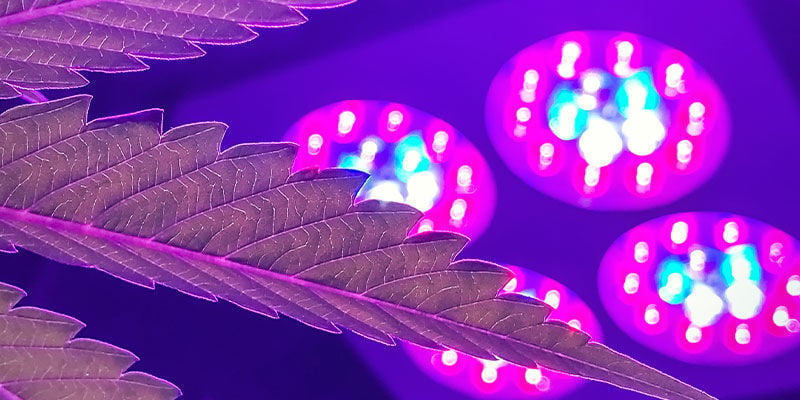
Cannabis grow lights have evolved immensely over the last century, and continue to do so as more places around the globe legalize and more people opt to grow their own weed.
If you’re reading this, chances are you already have some experience with cannabis grow lights and are familiar with the wide variety of lamps on the market. Still, it pays to revisit the different types of lights and how they affect cannabis.
CFL |
Compact fluorescent lights (CFLs) are very inexpensive and usually come in three different spectrums: warm/red (2700K), full-spectrum or daylight (5000K), and cool/blue (6500K). If you’ve got a CFL setup, we recommend using cool lights during veg and warm red lights for flowering.
HID |
High-Intensity Discharge (HID) lamps offer a variety of spectrums, perfect for targeting every growing phase of the plant. Usually, growers favour metal halide (MH) lamps for the vegetative stage, as they do a great job mimicking spring sunlight (more on the blue side of the spectrum). They tend to promote healthy root development and leafy growth. On the other hand, High-Pressure Sodium (HPS) lamps are preferred for flowering due to their orange/red tint. All HID grow lights benefit from the use of a hood or reflector to maximise their efficiency. And lastly, CMH are a newer type of HID lights. A hybrid between MH and HPS, the Ceramic Metal Halide grow lights have a more balanced spectrum and last longer.
LED |
LED lights, lastly, have quickly become the standard grow lights used not only to grow cannabis, but many other crops and plants. And there are good reasons for this; LEDs are far more efficient than CFL and HID lights, meaning they not only need to be replaced less often, but also produce far less heat (which can drive up the temperature of your grow room and cause all kinds of problems).
At Zamnesia, we are big fans of LED grow lights and recommend them for beginner, intermediate, and advanced growers. Thanks to the fast innovation and growth of the cannabis space, LED grow lights are more affordable than ever before, and most decent LED fixtures will come with veg and bloom settings with enhanced light spectrums for each stage of your plant's life.
Increase the Quality of Your Cannabis Harvests With the Ideal Light Spectrum
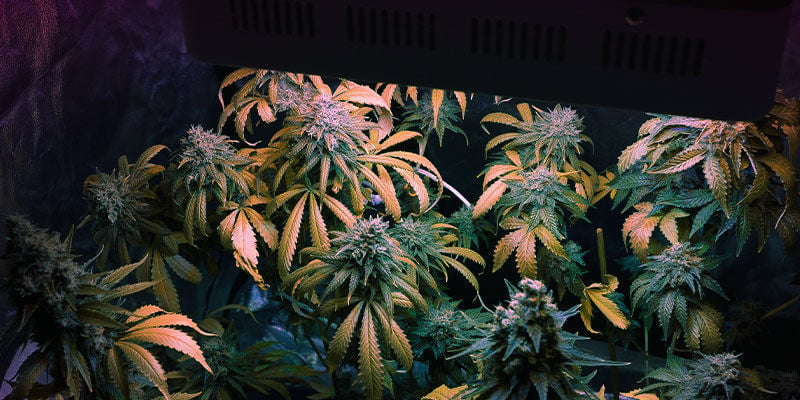
Cannabis is a hard, sun-loving plant that can grow well even in unfavourable conditions. Nonetheless, taking the time to wrap your head around certain specific grow topics, such as light spectrum, can help you make small tweaks to your indoor grow room/tent that can translate into noticeable increases in both the size and quality of your yields.
-
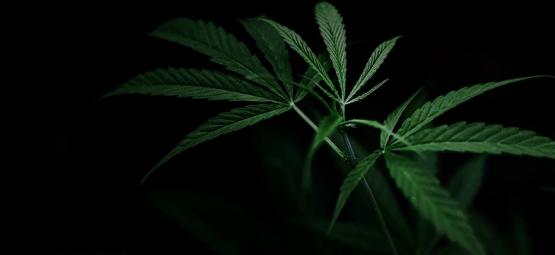
7 min 8 June, 2021 How To Control Cannabis Flowering With Light Deprivation Trying to harvest before the autumn rain or frost? Looking to achieve two harvests in one growing season? Light deprivation is a reliable and straightforward way to control the flowering phase of...
-
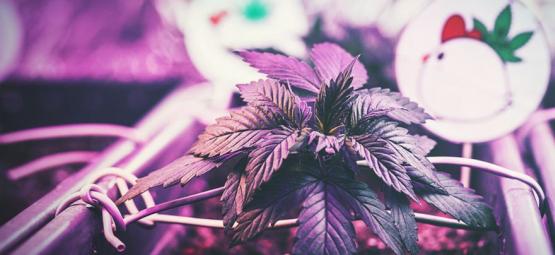
5 min 20 October, 2020 The Optimal Distance Between Grow Lights And Cannabis Plants Hanging a grow light in your grow room or tent is just one part of the story. To really get the most out of your cannabis plants, you need to hang your light at the optimal height to support robust...
-

3 min 7 June, 2020 How Much Sunlight Do Outdoor Cannabis Plants Need? If a great harvest is what you seek, you need to ensure that your outdoor cannabis plants can access plenty of sunlight. But how much sunlight does weed really need? Is there such a thing as too...
-
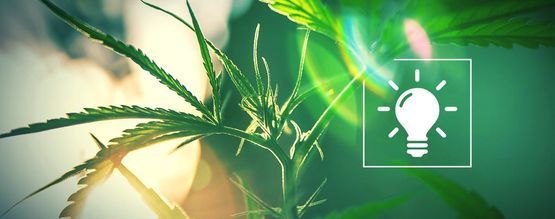
7 min 13 June, 2019 Choosing The Right Light For Your Grow-Op Cannabis plants have many demands, but none quite as important as lighting. A good set of lights are needed to ensure plants can photosynthesise properly and make enough energy to survive and...




 Seedshop
Seedshop Headshop
Headshop Vaporshop
Vaporshop Healthshop
Healthshop Smartshop
Smartshop Shroomshop
Shroomshop Plantshop
Plantshop United States
United States













